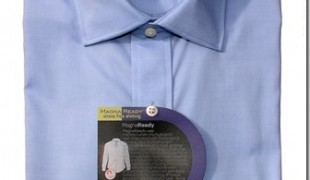- 7244
- 432
- 11
- 9
- 7
- Help Ukraine
About the solution
Gina Adams, a mother of two in Michigan, USA, saw firsthand the toll that Parkinson's disease took on her stepfather, especially when he was unable to do everyday things like button his own shirt.
"He was a brilliant engineer and a guitar player, and when he could no longer button his own shirt, it was devastating for him. I saw my stepdad with this whole closet of clothes he couldn't wear", Gina observed.
A few years later, when her children entered their teens, she came up with a solution to the problem that her stepfather had been facing along with millions of other people who have dexterity issues, that prevent them from getting dressed on their own.
She then created Buttons 2 Button, magnetic adapters that can be attached to button-down shirts. "My background is in the apparel industry, and I believe our clothes express ourselves and our identity. And it is so important for people to lead their lives with a sense of normalcy", the inventor explained.
The adapters can be used on any traditional button-down shirt. One part goes over the shirt button and the other part on the buttonhole to turn shirts into magnetic closures.
Gina said she envisions people using the adapters to help with everything from multiple sclerosis and arthritis to recovery from hand surgery and Parkinson's, the disease that struck her stepfather. "Helping people regain confidence, time and dignity is important", the innovator highlighted.
Adapted from: https://gma.abc/2xR8Nf6
More info: https://www.buttons2button.com
这些解决方案不应包括使用药物,化学品或生物制品(包括食品);创伤性设备;冒犯性的,商业或内在危险的内容。该解决方案未经医学验证。请谨慎进行!如果您有任何疑问,请咨询健康专家。
DISCLAIMER: This story was written by someone who is not the author of the solution, therefore please be advised that, although it was written with the utmost respect for the innovation and the innovator, there can be some incorrect statements. If you find any errors please contact the patient Innovation team via info@patient-innovation.com
-
• Sat, 12/31/2022 - 15:47
• Mon, 02/27/2023 - 15:21
我奶奶有帕金森氏病,75岁左右,7年前查出。现在,她的生活变得越来越困难,因为她的肌肉僵硬,甚至无法动弹。给予了左旋多巴和卡比多巴药物,但不会有太大的缓解作用。她不能进食,皮肤正在形成神经节损伤。我认为这可能是最后一个阶段,她服用的药物根本没有帮助,所以我开始对自然疗法进行大量研究,我被介绍给 Health Natural Center 和他们的帕金森氏草药方案。她从去年开始接受帕金森治疗,她的症状逐渐减轻,包括她的颤抖、身体无力和肌肉疼痛。在 healthnaturalcentre.org 上联系他们,自从开始这种治疗后,她又开始活跃了,她能够再次走路(在街上来回)她也恢复了锻炼以增强肌肉!!上帝保佑所有 PD 护理人员。保持坚强,在一天中花点时间感谢自己,爱自己,向你相信的任何信仰、明星、精神力量祈祷并祈求力量。我个人可以保证这些补救措施,但您可能需要决定什么最适合您。
• Thu, 09/12/2024 - 11:20
• Thu, 05/22/2025 - 09:53
4年前,我在60岁时被诊断出患有此病。症状是右腿震颤,失去书写能力(我原本漂亮的草书现在变得很小,打印得很困难,声音很轻)。我还难以从坐姿起身,并且有平衡问题。一开始我只服用Azilect,然后是Mirapex,然后是Sinemet。几个月前,我开始经常摔倒,因此才服用Sinemet。2021年夏天,我被介绍到Uinehealth Centre,并接受了他们有效的PD-5方案。治疗显著缓解了我的症状,效果优于处方药。我丈夫说,它在平衡、行走和从椅子上站起来的能力方面有很大帮助。现在我写字时手不会颤抖;我又能感觉到自己有力量了。我很幸运能得到丈夫和家人的爱心支持。我珍惜每一天!访问uinehealthcentre.net
-
-
753
-
0
-
13503

MagnaReady® - adaptative clothing for people who struggle with fine motor skills
Grip
CAREGIVING
Parkinson's Disease
Body-Worn solutions (Clothing, accessories, shoes, sensors...)
Assistive Daily Life Device (to help ADL)
Tremors
Stiffness or rigidity (difficulty moving)
Trouble with fine motor skills (e.g., writing, buttoning clothes)
Promoting self-management
Managing Neurological Disorders
Promoting inclusivity and social integration
Caregiving Support
Internal Medicine
Neurology
Physical Medicine and Rehabilitation
Rheumatology
United States
-
-
-
542
-
0
-
7389

Slacks with zippers on both sides for patients who have to stand up in public
CAREGIVING
(SELF)-CARE: DRESSING: Dressing independently.
Amyotrophic Lateral Sclerosis
Strategy/Tip
Body-Worn solutions (Clothing, accessories, shoes, sensors...)
Tremors
Muscle cramps or spasms
Stiffness or rigidity (difficulty moving)
Muscle weakness
Trouble with fine motor skills (e.g., writing, buttoning clothes)
Sleep disturbances
Numbness or tingling in the extremities
Restoring mobility
Managing pain
Promoting self-management
Managing Neurological Disorders
Promoting inclusivity and social integration
Preventing (Vaccination, Protection, Falls, Research/Mapping)
Caregiving Support
General and Family Medicine
Medical Genetics
Medical Oncology
Neurology
Orthopedics
Physical Medicine and Rehabilitation
Rheumatology
United States
-
-
-
464
-
0
-
6503

CAPR-Style – Adaptive clothing for disabled people
CAREGIVING
(SELF)-CARE: DRESSING: Dressing independently.
Incontinence
Cerebral Palsy
Cervical spinal cord injury/Tetraplegia
Body-Worn solutions (Clothing, accessories, shoes, sensors...)
Strategy/Tip
Promoting self-management
Managing Neurological Disorders
Promoting inclusivity and social integration
Recovering from Traumatic Injuries
Preventing (Vaccination, Protection, Falls, Research/Mapping)
Caregiving Support
Medical Genetics
Neurology
Pediatrics
Rheumatology
United Kingdom
-
This work is being financed by the FCT project with the reference PTDC/EGE-OGE/7995/2020
Copyright © 2025 Patient Innovation.
Powered by Orange Bird
Not a member yet? Register now, it's free!
 zh
zh
luciham20 • Wed, 07/24/2019 - 13:57